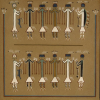Also known as hatałii in Navajo, singers, like medicine men, perform traditional ceremonial healing cures targeted at body, mind, and spirit, and call on the patient, his kin, the singer himself, and divine people to restore an individual's harmony with the world. Before a singer, or medicine man (they are seldom women), is called, a hand trembler (ndilniihii), often a woman, will diagnose the source of illness. Through prayer, concentration, and sprinkling of sacred pollen, her hand will tremble and pinpoint the cause, which then determines the proper ceremonial cure. Then a singer who knows the proper ceremony is called and preparations for the sing are set in motion.
There are nearly 100 Navajo sings, or chants, of varying range and intricacy. Originating from the Navajo Creation Story, they are so nuanced and complex that a singer learns only one or two sings over many years of apprenticeship. Sings last anywhere from one to nine days and include chants, songs, prayers, lectures, dances, sweat baths, prayer sticks, and sand paintings. In order for a sing to be effective, everything must be done as prescribed in the legends.











